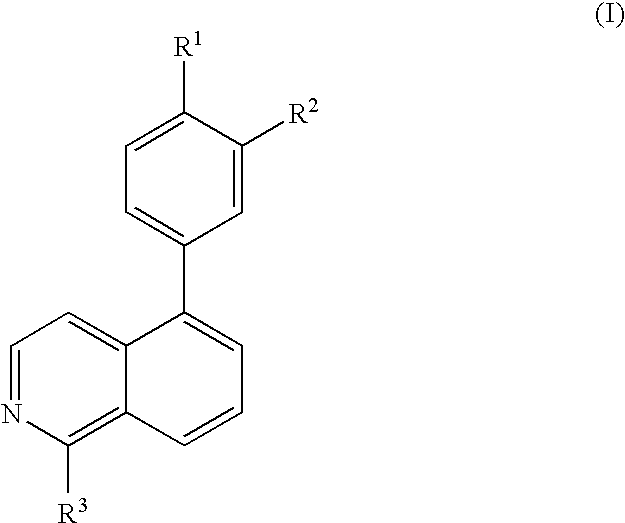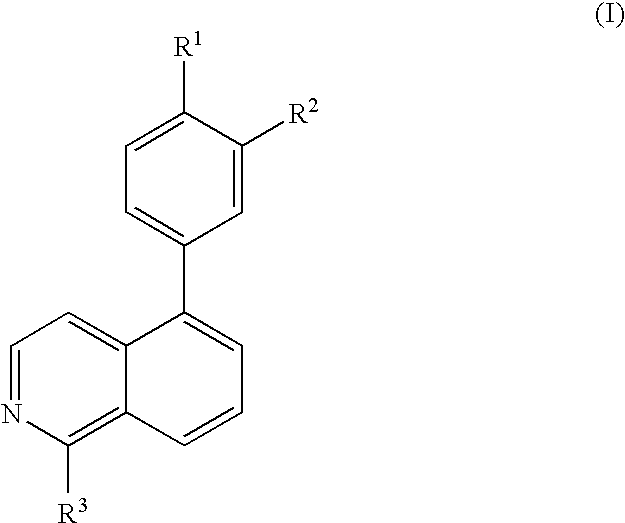Substitute isoquinolines useful in the treatment of diseases such as cancer and atherosclerosis
a technology of isoquinoline and substitute isoquinoline, which is applied in the direction of biocide, drug composition, cardiovascular disorder, etc., can solve the problems of high incidence of embyonic lethality, and achieve the effect of inhibiting the function of growth factor receptor
- Summary
- Abstract
- Description
- Claims
- Application Information
AI Technical Summary
Benefits of technology
Problems solved by technology
Method used
Image
Examples
example 1
1-(2-Fluoro-5-trifluoromethyl-phenyl)-3-(3-isoquinolin-5-ylphenyl)urea
[0147]
a. 5-Bromoisoquinoline
[0148]To a suspension of AlCl3 (156.7 g, 1.18 mol) in CH2Cl2 (500 mL), a solution of isoquinoline (605 mmol, 71 mL) in CH2Cl2 (100 mL) was dropwise added at such rate that the reaction mixture was refluxed gently. After addition, CH2Cl2 was removed by distillation. The blackish residue was melted at 120° C. then the temperature was adjusted to 100° C. To the mixture, Br2 (31 mL, 605 mmol) was dropwise added over 2 hrs at 100° C. and stirred for 30 min at same temperature, then was stirred at 75° C. overnight. The mixture was cooled to RT then carefully poured into ice-water. The aqueous mixture was basified with NaOHaq. and extracted with ether. The organics was dried over Na2SO4 then evaporated. Sequence purification on SiO2 column chromatography twice and recrystalisation (from hexane) gave the title compound (34.5 g, 28%).
b. 5-(3-Nitrophenyl)isoquinoline
[0149]A mixture of 5-bromoisoq...
example 2
Cyclohexyl-3-(3-isoquinolin-5-ylphenyl)urea
[0152]
[0153]The title compound was prepared from 5-(3-aminophenyl)isoquinoline and cyclohexyl isocyanate as described in example 1d.
example 3 and 4
1-[3-(1-Amino-isoquinolin-5-yl)-phenyl]-3-(2-fluoro-5-trifluoromethyl-phenyl)-urea (Example 3) and 1-(2-fluoro-5-trifluoromethyl-phenyl)-3-(5-{3-[3-(2-fluoro-5-trifluoromethyl-phenyl)-ureido]-phenyl}-isoquinolin-1-yl)-urea (Example 4)
[0154]
a. 5-Bromoisoquinoline N-oxide
[0155]To a solution of 5-bromoisoquinoline (20.8 g, 100 mmol) in CH2Cl2 (500 mL), mCPBA (80% assay, 23.7 g, 110 mmol) was added and stirred at 45° C. overnight. After cooling, the mixture was quenched with Na2S2O3 then extracted with CH2Cl2. The organic layer was washed with NaOHaq., dried over Na2SO4 then evaporated. Sequence recrystalisation (from CH2Cl2-ether) gave the title compound (20.1 g, 90%).
b. 5-Bromo-1-chloroisoquinoline
[0156]To a solution of 5-bromoisoquinoline N-oxide (20.1 g, 89.5 mmol) in CH2Cl2 (500 mL), POCl3 (20 mL, 215 mmol) was added and stirred at 45° C. overnight. After cooling, the mixture was evaporated to remove POCl3 then added water. The mixture was extracted with CH2Cl2. The organic layer w...
PUM
 Login to View More
Login to View More Abstract
Description
Claims
Application Information
 Login to View More
Login to View More - R&D
- Intellectual Property
- Life Sciences
- Materials
- Tech Scout
- Unparalleled Data Quality
- Higher Quality Content
- 60% Fewer Hallucinations
Browse by: Latest US Patents, China's latest patents, Technical Efficacy Thesaurus, Application Domain, Technology Topic, Popular Technical Reports.
© 2025 PatSnap. All rights reserved.Legal|Privacy policy|Modern Slavery Act Transparency Statement|Sitemap|About US| Contact US: help@patsnap.com



